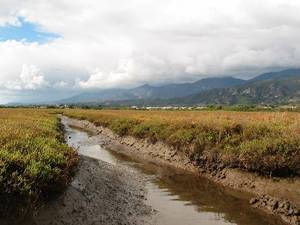Salt Marshes - Planet Earth Online
Interview with
One of Britain's most unusual landscapes can be found along its coastline.
Salt marshes are home to unique species of plants, provide breeding grounds for birds and act as natural flood defences.
Over the years, many salt marshes have been lost to agriculture or reclaimed for development but now there are several major projects underway to restore areas of coastline back to their natural state.
However, as Planet Earth Podcast presenter Richard Hollingham has been finding out in North Norfolk, a new study has found restoring salt marshes is extremely difficult...
Richard - I'm looking out across a vast salt marsh. There are channels of water, rather a lot of mud, tufts of vegetation, patches of brown and green and the odd yellow flower poking through - just beyond the horizon there should be the sea. There's a wind farm offshore in the distance. This is Stiffkey, a salt marsh almost exactly midway along the north Norfolk coast and with me is Alastair Grant from the University of East Anglia...
 Alastair - Salt marsh is covered with terrestrial plants but several times a month the salt marsh will be covered by sea water, so the terrestrial plants that live here have to be able to cope with full strength sea water. Almost no plants can do that so we're dealing with unique biodiversity plants that only live on salt marshes and aren't found anywhere else.
Alastair - Salt marsh is covered with terrestrial plants but several times a month the salt marsh will be covered by sea water, so the terrestrial plants that live here have to be able to cope with full strength sea water. Almost no plants can do that so we're dealing with unique biodiversity plants that only live on salt marshes and aren't found anywhere else.
Richard - Now you've been looking at projects to recreate salt marshes.
Alastair - That's right. There used to be huge areas of salt marsh around the UK, the great majority of those have been reclaimed for use as agricultural land. We're now down to about 40 square kilometres of salt marsh in the whole of England and Wales. That salt marsh is eroding as a result of sea level rise and other pressures. As a result of that there's actually a legal requirement on the Government to create salt marsh to replace any salt marsh that is being lost to coastal erosion, if you want to build a new port that involves destroying salt marsh or indeed mud flat then you have to create habitat to replace the habitat that is being lost to the coastal development.
Richard - But what you found with your study is that recreating it, it doesn't end up as the same.
Alastair - That's right. Because salt marshes develop naturally on mud on the upper intertidal, everyone assumed that all you would need to do would be to let the sea back in and nature would take its course. But actually it is not that simple. Sites that were created 20 years ago now still lack many of the most interesting species - sea lavender, for example, one of the most charismatic of the plant species is almost completely absent from created marshes. And it is not just a question of time. So, we've looked at sites that were flooded accidentally, in some cases more than a century ago and they still are not like natural salt marshes. They are a bit better but they still lack many of these perennial species, many of the more interesting species and don't recreate the biodiversity or the landscape characteristics of the natural marshes.
Richard - So why do you think that is? What do you think is going on?
Alastair - It seems to be down to the environmental conditions, so what happens when you take a salt marsh and drain it for agricultural use? The salt is washed out of the soil, the soil texture changes, the organic carbon in the soil oxidises and the soil shrinks and when that is flooded again it tends to be rather too consolidated. On the upper salt marsh it can be very hard, almost like concrete, on the lower salt marsh it is often too water-logged so it is a bit like having a pot plant where you give it too much water, the soil becomes deoxygenated and very few plants can survive in those conditions.
Richard - So what does that mean? I suppose it means we must preserve the salt marsh that still exists and, what, do your best to get salt marsh back?
Alastair - Yes, it certainly means that we should preserve the salt marsh that we've got, particularly the upper more diverse marsh which is so difficult to recreate. Since we did the work that is described in this paper we've actually been looking at ways that you can manipulate the environment to try to make conditions better. We've also been looking at planting these more interesting plants and we can establish them if we establish the right conditions then we can establish the plants and the survival of those transplanted plants is very high.
Richard - So the bottom line is preserve what's here?
Alastair - Certainly wherever possible preserve what's here.
- Previous The Plight of British Oyster Beds
- Next Preservation of Parasites










Comments
Add a comment